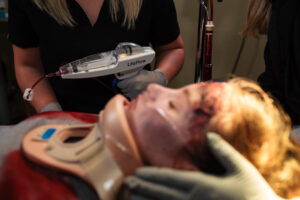
Pediatric patients account for 25% of all emergency department (ED) visits nationwide.1 When a trauma patient arrives with significantly depleted volume due to hemorrhage, rapid blood administration is an essential intervention for maintaining adequate tissue perfusion.
However, traditional rapid infusion methods, including the push-pull technique, IV pumps, large pole-mounted rapid infusers, and pressure bags, are not optimized for pediatric patients or the pressing time concerns surrounding their care.2,3 These methods are often too slow, cumbersome to set up, or pose a safety risk.
The following case describes two pediatric motor vehicle accident (MVA) patients received at a regional trauma center and the effects of using a novel handheld rapid infuser for rapid volume administration.
Case Presentation
The Mt. Graham Regional Medical Center in Safford, Arizona is a 25-bed critical access hospital with a Level IV Trauma Center certified Emergency Department. The ED received a call from EMS that two pediatric patients had been involved in a severe MVA in which they were both ejected from the vehicle, and both caregivers died at the scene.
The first patient, a two-year-old, arrived at the ED unconscious and unresponsive with a presumed head injury. Initial assessment revealed that the patient was tachycardic for their age, and EMS reported a heart rate of 150-160 in transit. The patient also displayed classic signs of shock and appeared mottled with cool, diaphoretic skin.
The patient’s four-year-old sibling arrived at the same time with altered mental status and vomiting. A head injury was also suspected for this patient. Over ten minutes, the second patient’s status deteriorated, resulting in the need for intubation. Based on the patient’s initial presentation, the team was able to acquire labwork indicating low hemoglobin and hematocrit values.
Due to the patients’ ages and critical status, the team was unable to obtain an accurate blood pressure reading for either during the initial assessment period. Neither patient was known to have a significant prior medical history.
Management
The two-year-old patient’s unresponsive state prompted the medical team to intubate immediately upon arrival. Intraosseous (IO) access was also established, and a rapid blood transfusion was ordered to treat suspected shock.
Providers used the LifeFlow PLUS handheld rapid infuser to administer 120 mL of packed red blood cells (PRBCs) via the IO site over ten minutes. Following a reassessment that failed to show improvement, the patient was given another 120 mL bolus of PRBCs over 10 minutes using the LifeFlow device.
Following the four-year-old patient’s deterioration in the ED, intubation was also necessary. The patient’s symptoms, also indicative of shock, prompted the team to administer a 170 mL infusion of PRBCs over 30 minutes using the LifeFlow PLUS.
The blood infusions for both patients were warmed according to facility protocol using a QinFlow Warrior warmer.
Following blood administration, both patients demonstrated improvement. Both patients’ skin became warm and dry and showed decreased mottling. The two-year-old patient did not regain consciousness but had an improved heart rate of 110. The team’s findings did not indicate the need for further rapid volume administration, and neither patient required pressor medications to stabilize their vital signs.
Following these interventions, both patients remained intubated and were transferred to a Level I pediatric facility.
Discussion
There is a pressing need for improved pediatric readiness in U.S. hospitals. Currently, just 23 states have a pediatric readiness program, despite data showing that hospitals that meet readiness criteria see 76% lower mortality rates in ill children and 60% lower mortality rates in injured children.4 This case demonstrates the life-saving impact of being prepared to stabilize even the most critical pediatric patients with rapid blood or fluid resuscitation.
The Mt. Graham ED had received LifeFlow units just one week prior to the arrival of these two patients. Thanks to the device’s simple setup and ease of use, the nurses could use them to stabilize two critically injured patients with minimal training.
One clinician noted how the simplicity of LifeFlow, including the minimal training required to set up and operate it in a chaotic situation, helped the emergency team immensely.
LifeFlow PLUS takes just three minutes for a new user to set up and about one minute for an experienced user. This allows providers to begin infusing fluids and blood products much faster than traditional methods so they can begin stabilizing patients in shock. Rapid infusion with LifeFlow also allows providers to immediately reassess the patient, determine the efficacy of each intervention, and order additional blood or fluids if needed.
Speaking on the importance of pediatric readiness, a hospital representative commented, “We see roughly four to eight really critical peds patients per year… now we’re seeing some of these patients survive that realistically would not have before.”
In a race against the clock, LifeFlow is a fast, effective solution for rapid volume resuscitation. For pediatrics in particular, LifeFlow offers a tool for rapid and controlled administration of blood and IV fluids that make it simple and easy, even for hospitals who don’t frequently see critically ill or injured pediatric patients.
- Institute of Medicine. 2007. Emergency Care for Children: Growing Pains. Washington, DC: The National Academies Press. https://doi.org/10.17226/11655.
- Piehl, M., Park, C.W. When Minutes Matter: Rapid Infusion in Emergency Care. Curr Emerg Hosp Med Rep9, 116–125 (2021). https://doi.org/10.1007/s40138-021-00237-6
- Robertson G, Lane A, Piehl M, Whitefill T, Spangler H. Comparison of a novel rapid fluid delivery device to traditional methods. https://410medical.com/wp-content/uploads/2018/03/Infusion-Rate-Comparison-of-LifeFlow-to-Traditional-Methods.pdf.
- Remick KE, Hewes HA, Ely M, et al. National Assessment of Pediatric Readiness of US Emergency Departments During the COVID-19 Pandemic. JAMA Netw Open. 2023;6(7):e2321707. doi:10.1001/jamanetworkopen.2023.21707

